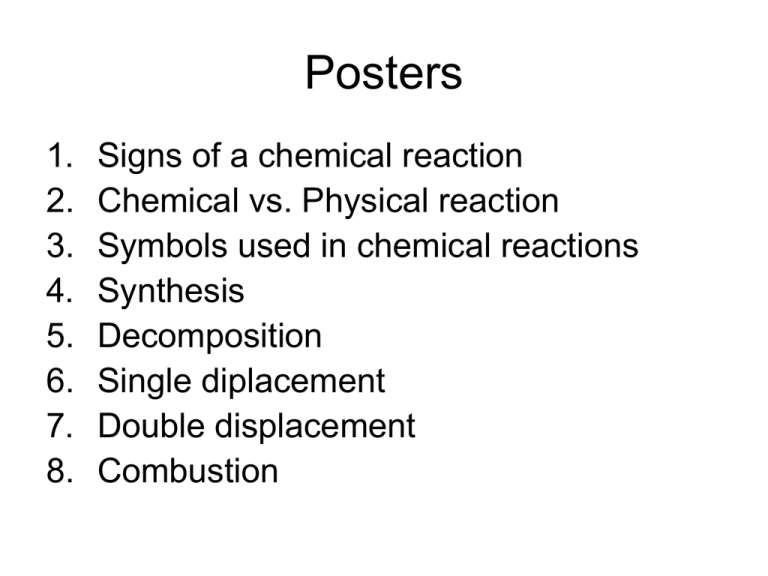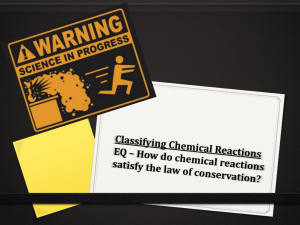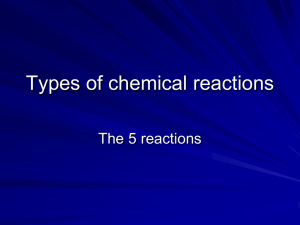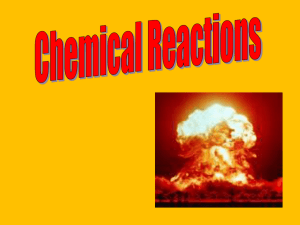The 5 Types of Reactions
advertisement

Posters 1. 2. 3. 4. 5. 6. 7. 8. Signs of a chemical reaction Chemical vs. Physical reaction Symbols used in chemical reactions Synthesis Decomposition Single diplacement Double displacement Combustion Journal Entry • How were these rocks formed? Signs of a chemical reaction • • • • • • Production of…. Heat Light Gas Precipitate (solid formed from two liquids) Color change The 5 Types of Reactions We classify reactions into 5 categories so that we may more easily predict the products. NEXT Synthesis Definition Synthesis reaction – 2 substances are combined to form a single product • Combination reactions may also be called composition or synthesis reactions. A + B AB + MENU Synthesis Examples 2Mg + O2 2MgO Magnesium and oxygen combine to form magnesium oxide. 2H2 + O2 2H2O Hydrogen and oxygen combine to form dihydrogen monoxide (water) MENU Synthesis Demonstration Zinc + Sulfur Zinc Sulfide Zn + S ZnS Observations: Decomposition Definition Decomposition reaction – A single compound is broken down into 2 or more products. AB A + B + MENU Decomposition Examples 2NaCl(s) 2Na(s) + Cl2(g) Sodium chloride (table salt) decomposes into sodium and chlorine gas. CaCO3 CaO + CO2 Limestone (CaCO3 ) decomposes into lime (CaO) and carbon dioxide. MENU Decomposition 2 H2O 2H2 + O2 Water decomposing into hydrogen gas and oxygen gas. Decomposition of H2O2 MENU Decomposition Demonstration C12H22O11 + H2SO4 → C + H2O + SO2 (balance this!) Sugar + Sulfuric acid Pure carbon + Water + Sulfur dioxide Observations: Decomposition Demonstration • 2 NaHCO3 --> Na2CO3 + H2O + CO2 Observations: Massinitial Massfinal Combustion Definition Combustion reaction – Hydrogen or a hydrocarbon (H and C) burn in oxygen to produce water and carbon dioxide. Heat is given off as energy. CxHx + O2 XH2O + XCO2 MENU Combustion Examples CH4 + 2O2 2H2O + CO2 Methane burns in oxygen to produce water and carbon dioxide. C12H22O11 + 12O2 11H2O + 12CO2 A sugar molecule burns in oxygen to produce water and carbon dioxide. MENU Combustion demonstration • Ethanol + Oxygen yields Water + Carbon dioxide C6H12O6 + O2 H2O + CO2 Single Replacement Definition Single Replacement reaction – A single element takes the place of an element in a compound. A + BC B + AC + + MENU Single Replacement Examples Mg + BeO Be + MgO Magnesium replaces beryllium in beryllium oxide to form magnesium oxide and beryllium. 2Na + 2HCl H2 + 2NaCl Sodium replaces hydrogen in hydrochloric acid to yield hydrogen and sodium chloride. MENU Single Replacement Demo. A single replacement of Zinc metal for hydrogen in hydrochloric acid. Zn + 2HCl H2 + ZnCl2 Double Replacement Definition Double Replacement reaction – Elements in 2 compounds switch places to form 2 new compounds. AB + CD AD + CB + + MENU Double Replacement Examples MgO + BeS MgS + BeO Oxygen and sulfur switch places to form magnesium sulfide and beryllium oxide. Na2S + Zn(NO3)2 2Na(NO3) + ZnS Sulfur and nitrate switch places to form sodium nitrate and zinc sulfide. Make a Venn diagram comparing…. • Synthesis vs. Decomposition • Single replacement vs. double replacement What type of reaction? • 2 H2 + O2 -- 2H20 What type of reaction? • A + BX AX + B What type of reaction? AgNO3 + CuSO4 AgSO4 + CuNO3 What type of reaction is this? • 2 HCl (aq) + Zn (s) --> ZnCl2 (aq) + H2 (g) What type of reaction? Counting atoms • How many Carbons are in each of the following compounds: – CO2 – C2H6 – Na(CO3)2 – Mg(C2O)4 Warm-up • Around the room there are _7__ pictures representing types of reactions. YOUR pictures. • Make a list in your notebook, 1- _7__. Try to determine what type of reaction is being represented by the drawing. Definitions • Co-efficient: The number before an element/compound (allowed to change when balancing) – Ex: 2 H2 • Subscript: The small number after an element/compound (NEVER allowed to change when balancing – Ex: 2 H2 Sacrificial Gummy Bear • Demonstrates: – Two types of chemical reactions – HIGHLY Exothermic energy change – Chemical energy converted into thermal, radiant and sound energy Chemicals used • KClO3 - Potassium chlorate • C12H22O11 - Sucrose First reaction KClO3 (s) KCl (l) + O2 What type of reaction is this? First reaction KClO3 (s) KCl (l) + O2 Is this reaction balanced? (Make an RT table) First reaction KClO3 (s) KCl (l) + O2 Balance it! First reaction 2 KClO3 (s) 2 KCl (l) + 3 O2 (g) First reaction 2 KClO3 (s) 2 KCl (l) + 3 O2 (g) Second reaction C12H22O11 + O2 (g) C (s) + CO2 (g) + H2O (g) What type of reaction is this? Second reaction C12H22O11 + O2 (g) C (s) + CO2 (g) + H2O (g) Is it balanced? (Make an R/P table) If not, balance it! (1 min. early release if done correctly!) Second reaction C12H22O11 + 3 O2 9 C + 3 CO2 + 11 H2O Balanced equation Exothermic • Reactions which release energy ∆H = 5635 kJ How to balance equations • 1.) Create a “R/P” table – (Reactants vs. Products) • 2.) Add coefficients to create equal numbers • 3.) update the R/P table • 4.) Change co-efficients until R = P Pre-lab/practice • Purpose: To generate hydrogen gas – To set norms of behavior when dealing with acid Norms: Locations • Ring stands are on top of fume hood • Clamps are in 4A • All other materials are on counter by sink 1 Materials • • • • Ring stand/clamp Test tube 1-2 pea-size chunks of Zn 1 bottle of HCl Procedure • Set up your apparatus as demonstrated • Add the Zinc to the test tube • Add approximately 2-4 cm of HCl to the test tube • Cover with a small piece of aluminum foil • Look for signs of a chemical reaction • Allow to react for 3-4 minutes Test • Raise your hand when time has elapsed • Use the flame test to look for signs of H2 gas Clean up • All test tubes must be cleaned out with Alconox • Make sure that all acid is flushed with a large amount of water • Sinks are to be totally clean Homework reminder • Read and take notes on pages 256-264 • Answer questions 1 and 2 • Due next class



